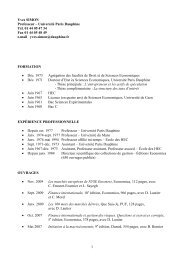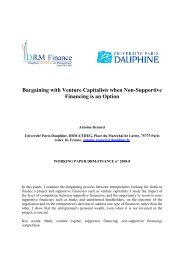Internal versus External growth: impact on operational and ... - CEREG
Internal versus External growth: impact on operational and ... - CEREG
Internal versus External growth: impact on operational and ... - CEREG
You also want an ePaper? Increase the reach of your titles
YUMPU automatically turns print PDFs into web optimized ePapers that Google loves.
<str<strong>on</strong>g>Internal</str<strong>on</strong>g> <str<strong>on</strong>g>versus</str<strong>on</strong>g> <str<strong>on</strong>g>External</str<strong>on</strong>g> <str<strong>on</strong>g>growth</str<strong>on</strong>g>: <str<strong>on</strong>g>impact</str<strong>on</strong>g> <strong>on</strong> operati<strong>on</strong>al <strong>and</strong> market<br />
performance<br />
Vassilis Samaras<br />
Working Paper : August 2007<br />
Abstract<br />
We examine the operati<strong>on</strong>al <strong>and</strong> market performance of all industrial US companies listed in the NYSE, AMEX<br />
<strong>and</strong> NASDAQ between January 1990 <strong>and</strong> December 2004. The results indicate that growing up internally <strong>and</strong><br />
externally has a significantly positive effect <strong>on</strong> the abnormal returns of the firm. Moreover, growing up<br />
internally increases abnormal returns significantly more than growing up externally. In additi<strong>on</strong>, firms that grew<br />
up internally increased their cumulated cash flow returns – up to a certain point of internal <str<strong>on</strong>g>growth</str<strong>on</strong>g> – <strong>and</strong> enjoyed<br />
significantly higher cumulated cash flow returns than the companies that grew up externally.<br />
1. Introducti<strong>on</strong><br />
A firm can grow in two ways: either by performing mergers <strong>and</strong> acquisiti<strong>on</strong>s (external<br />
<str<strong>on</strong>g>growth</str<strong>on</strong>g>), or by increasing its own assets or output through the reinvestment of its cash flows in<br />
existing businesses (internal or organic <str<strong>on</strong>g>growth</str<strong>on</strong>g>). Both types of <str<strong>on</strong>g>growth</str<strong>on</strong>g> strategies are regularly<br />
used simultaneously, <strong>and</strong> have advantages <strong>and</strong> drawbacks. <str<strong>on</strong>g>External</str<strong>on</strong>g> <str<strong>on</strong>g>growth</str<strong>on</strong>g> creates synergies<br />
<strong>and</strong> market power, but it can also destroy value if the management reinvests the firm’s<br />
resources or free cash flows in inefficient projects for their own pers<strong>on</strong>al interest.<br />
Alternatively, internal <str<strong>on</strong>g>growth</str<strong>on</strong>g> provides more corporate c<strong>on</strong>trol, encourages internal<br />
entrepreneurship, <strong>and</strong> protects organizati<strong>on</strong>al culture, but it often is a slower way of <str<strong>on</strong>g>growth</str<strong>on</strong>g><br />
compared to M&As since it requires the development of new resources internally. Therefore,<br />
the managerial choice between those two types of <str<strong>on</strong>g>growth</str<strong>on</strong>g> will have a c<strong>on</strong>sequential <str<strong>on</strong>g>impact</str<strong>on</strong>g> <strong>on</strong><br />
the firm’s operati<strong>on</strong>al <strong>and</strong> market performance. The business risk associated with each type of<br />
<str<strong>on</strong>g>growth</str<strong>on</strong>g> varies, <strong>and</strong> depends <strong>on</strong> various determinants such as the industry or the ec<strong>on</strong>omical<br />
envir<strong>on</strong>ment.<br />
1
Moreover, c<strong>on</strong>sulting firms such as Bain 1 or BCG 2 are encouraging companies to perform<br />
M&As, arguing that the more external <str<strong>on</strong>g>growth</str<strong>on</strong>g> they do, the more their financial <strong>and</strong> ec<strong>on</strong>omic<br />
performance will increase. BCG’s report quotes that the highly acquisitive companies of their<br />
US sample have the highest mean total shareholder return, <strong>and</strong> that the most successful<br />
acquisitive growers outperformed the most successful organic growers, allowing them to gain<br />
market share more rapidly than their counterparts.<br />
On the other h<strong>and</strong>, General Electric has recently praised the advantages of organic <str<strong>on</strong>g>growth</str<strong>on</strong>g> 3<br />
<strong>and</strong> encourages companies to pursue it because of the lower costs, the better return of<br />
investment <strong>and</strong> the incentives that it gives to pursue innovati<strong>on</strong>. GE also emphasizes that<br />
when Procter & Gamble <strong>and</strong> Gillette appeared at a meeting in Ariz<strong>on</strong>a so<strong>on</strong> after announcing<br />
their merger, A.G. Lafley, P&G’s CEO, explained that his company is no l<strong>on</strong>ger dependent <strong>on</strong><br />
mergers to c<strong>on</strong>tinue sales <strong>and</strong> profit <str<strong>on</strong>g>growth</str<strong>on</strong>g> <strong>and</strong> insisted that “[his] <str<strong>on</strong>g>growth</str<strong>on</strong>g> has been quality<br />
<str<strong>on</strong>g>growth</str<strong>on</strong>g> because of organic <str<strong>on</strong>g>growth</str<strong>on</strong>g>”. Lafley has often been credited with revitalizing the<br />
company by building <strong>on</strong> P&G’s core br<strong>and</strong>s such as Crest <strong>and</strong> Pampers. Another interesting<br />
example is Starbucks. While Starbucks has made some acquisiti<strong>on</strong>s, such as the 60-outlet<br />
Seattle Coffee Company to enter the U.K. market in 1998, their main objective has been the<br />
development of internal <str<strong>on</strong>g>growth</str<strong>on</strong>g> which brought the total number of their worldwide outlets<br />
bey<strong>on</strong>d 13000 as of 2007.<br />
Should the companies focus <strong>on</strong> M&As or would they be better off by investing those<br />
resources internally instead? This paper will attempt to provide an answer to that questi<strong>on</strong>.<br />
More specifically, we will analyse the operati<strong>on</strong>al <strong>and</strong> financial performance of US<br />
companies between January 1990 <strong>and</strong> December 2004, <strong>and</strong> compare the performance of the<br />
firms that performed internal <str<strong>on</strong>g>growth</str<strong>on</strong>g> with those that did external <str<strong>on</strong>g>growth</str<strong>on</strong>g>.<br />
In secti<strong>on</strong> 4, we find evidence that growing up internally <strong>and</strong> externally has a significantly<br />
positive effect <strong>on</strong> the abnormal returns of the firm. Moreover, growing up internally increases<br />
abnormal returns significantly more than growing up externally. In additi<strong>on</strong>, firms that grew<br />
up internally increased their cumulated cash flow returns – up to a certain point of internal<br />
1 Source : Bain & Company Global Learning Curve Study (2003)<br />
2 Source : The Bost<strong>on</strong> C<strong>on</strong>sulting Group, Growing through Acquisiti<strong>on</strong>s : The successful Value Creati<strong>on</strong> record<br />
of Acquisitive Growth Strategies (2004)<br />
3 Source : General Electric Commercial Finance report : Leading views from GE (May 2005)<br />
2
<str<strong>on</strong>g>growth</str<strong>on</strong>g> – <strong>and</strong> enjoyed significantly higher cash flow returns than the companies that grew up<br />
externally.<br />
The rest of the paper is presented as follows. The next secti<strong>on</strong> provides an overview of the<br />
literature review. Secti<strong>on</strong> 3 describes the sample <strong>and</strong> the research design. Secti<strong>on</strong> 4 provides<br />
the results of the operati<strong>on</strong>al <strong>and</strong> market performance for each type of <str<strong>on</strong>g>growth</str<strong>on</strong>g> strategy.<br />
Secti<strong>on</strong> 5 c<strong>on</strong>cludes this paper.<br />
3
2. Literature review<br />
Past literature typically studies either the corporate performance or the market performance of<br />
firms following mergers <strong>and</strong> acquisiti<strong>on</strong>s. Nevertheless, little research has been made about<br />
the performance related to internal <str<strong>on</strong>g>growth</str<strong>on</strong>g>. This secti<strong>on</strong> will first analyze the different<br />
rati<strong>on</strong>ales for each type of <str<strong>on</strong>g>growth</str<strong>on</strong>g> strategies, <strong>and</strong> will then summarize the main findings of<br />
previous empirical research <strong>on</strong> market (short term <strong>and</strong> l<strong>on</strong>g term) <strong>and</strong> operati<strong>on</strong>al<br />
performance.<br />
2.1 Value effects of external <strong>and</strong> internal <str<strong>on</strong>g>growth</str<strong>on</strong>g> strategies<br />
As menti<strong>on</strong>ed before, two of the rati<strong>on</strong>ales for c<strong>on</strong>ducting external <str<strong>on</strong>g>growth</str<strong>on</strong>g> are synergies<br />
between the combining firms <strong>and</strong> the creati<strong>on</strong> market power.<br />
Synergy gains can be defined as the ability of a combinati<strong>on</strong> to be more profitable than the<br />
individual units that are combining (Gaughan, 2002). The origins of these synergies are<br />
diverse. Firstly, they can originate from ec<strong>on</strong>omies of scale or scope (Peteraf, 1993). For<br />
example, Dranove <strong>and</strong> Shanley (1995) analyzed the source of the gains of ec<strong>on</strong>omies in<br />
producti<strong>on</strong>, administrati<strong>on</strong> <strong>and</strong> marketing in hospital systems c<strong>on</strong>sequential to mergers <strong>and</strong><br />
acquisiti<strong>on</strong>s. Sec<strong>on</strong>dly, synergies may derive from better corporate c<strong>on</strong>trol <strong>on</strong> the target firm<br />
(Jensen, 1988) because managers often have trouble ab<strong>and</strong><strong>on</strong>ing old strategies <strong>and</strong> habits that<br />
are unhealthy for their company. Takeovers can help solving those problems because it’s<br />
easier for new top-level managers that had no close bound with the company to make the<br />
adequate changes. Moreover, resistance to organizati<strong>on</strong>al change is usually significantly<br />
lower when top-level managers have been recently appointed. Finally, synergies may appear<br />
from new co-specialized assets, as explained theoretically by Teece (1986), <strong>and</strong> verified<br />
empirically by Capr<strong>on</strong> (1999).<br />
Another rati<strong>on</strong>ale for merging is market power. Market power refers to the capacity of a<br />
company to act independently of its competitors <strong>and</strong> clients (Carlt<strong>on</strong> <strong>and</strong> Perlof, 1990; Hay<br />
<strong>and</strong> Morris, 1991). Eckbo (1983) tested the collusi<strong>on</strong> hypothesis (i.e., “that rivals of the<br />
merging firms benefit from the merger since successful collusi<strong>on</strong> limits output <strong>and</strong> raises<br />
product prices <strong>and</strong>/or lower factor prices”) <strong>and</strong> finds little evidence indicating that the mergers<br />
4
would have had collusive effects. Eckbo (1992) also compared the Canadian market, which<br />
lacked any antitrust policy for a l<strong>on</strong>g period of time, with the US market to test the deterrence<br />
hypothesis (i.e., “that the probability of a horiz<strong>on</strong>tal merger being anti-competitive is higher<br />
in Canada than in the US”). Again, there was no solid evidence supporting the hypothesis.<br />
Several other empirical studies, such as Sharma <strong>and</strong> Thistle (1996) in the US market, implied<br />
a lack of significant post-merger market power gains to be able to influence the product<br />
markets.<br />
Acquisiti<strong>on</strong>s can also destroy value if the management reinvests the firm’s resources, or free<br />
cash flows, for their own pers<strong>on</strong>al interest in inefficient projects. Amihud <strong>and</strong> Lev (1981)<br />
empirically examined the motives for the widespread <strong>and</strong> persisting phenomen<strong>on</strong> of<br />
c<strong>on</strong>glomerate mergers. Why do managers perform these c<strong>on</strong>glomerate mergers if investors<br />
can achieve the same diversificati<strong>on</strong> effect in their own portfolios, according to their own risk<br />
aversi<strong>on</strong>? They c<strong>on</strong>clude that managers are engaging in c<strong>on</strong>glomerate mergers “to decrease<br />
their largely undiversifiable “employment risk” (i.e., risk of losing job, professi<strong>on</strong>al reputati<strong>on</strong>,<br />
etc.)”. Jensen (1986) brings his free cash flow theory to explain why mergers occur. Free cash<br />
flows are cash flows in excess of what is required to fund all projects with positive net present<br />
value. Agency costs occur when there are substantial free-cash flows that are reinvested<br />
inefficiently by the managers (e.g. by performing firm combinati<strong>on</strong>s), instead of redistributing<br />
them directly to their shareholders through dividend payments. Yet another example is the<br />
paper from Shleifer <strong>and</strong> Vishny (1989) that describes how managers can entrench themselves<br />
with manager-specific investments that make it costly for shareholder to replace them. Those<br />
manager-specific investments also provide the opportunity for managers to extract higher<br />
wages <strong>and</strong> to have more c<strong>on</strong>trol over the corporate strategy of the company. A last source of<br />
value-destructi<strong>on</strong> in combinati<strong>on</strong>s is poor post-merger integrati<strong>on</strong>. Datta (1991) empirically<br />
examines the organizati<strong>on</strong>al differences between US bidders <strong>and</strong> targets of M&As <strong>on</strong> postacquisiti<strong>on</strong><br />
performance. He c<strong>on</strong>cludes that differences in top management styles negatively<br />
<str<strong>on</strong>g>impact</str<strong>on</strong>g> post-acquisiti<strong>on</strong> performance. However, difference in reward <strong>and</strong> evaluati<strong>on</strong> systems<br />
didn’t seem to <str<strong>on</strong>g>impact</str<strong>on</strong>g> the post-acquisiti<strong>on</strong> performance significantly.<br />
On the other h<strong>and</strong>, internal <str<strong>on</strong>g>growth</str<strong>on</strong>g> provides more corporate c<strong>on</strong>trol, encourages internal<br />
entrepreneurship <strong>and</strong> protects organizati<strong>on</strong>al culture for different reas<strong>on</strong>s. First of all,<br />
managers have a better knowledge of their own firm <strong>and</strong> assets, <strong>and</strong> the internal investment is<br />
likely to be better planned <strong>and</strong> efficient. In additi<strong>on</strong>, synergies may also be costly to exploit,<br />
5
making it again more interesting to invest internally (Denrell, Fang <strong>and</strong> Winter, 2003).<br />
Moreover, as explained earlier, internal <str<strong>on</strong>g>growth</str<strong>on</strong>g> prevents top management styles <strong>and</strong> firm<br />
structures differences which destroy value in combinati<strong>on</strong>s (Datta, 1991). Finally, companies<br />
that are investing internally are also able to create sustainable competitive advantages since<br />
their value-creating processes <strong>and</strong> positi<strong>on</strong>s are less likely to be duplicated or imitated by<br />
other firms. <str<strong>on</strong>g>Internal</str<strong>on</strong>g> <str<strong>on</strong>g>growth</str<strong>on</strong>g> strategies are more private <strong>and</strong> less pr<strong>on</strong>e to any hostile acti<strong>on</strong><br />
from other companies. This leads to better rewards from the capital market (Barney, 1998).<br />
2.2 <str<strong>on</strong>g>External</str<strong>on</strong>g> Growth <strong>and</strong> performance<br />
2.2.1 Market performance<br />
Short term <strong>and</strong> l<strong>on</strong>g term market performance around the announcement dates of the<br />
combinati<strong>on</strong>s have been broadly studied in the past literature.<br />
Although target companies levered significantly positive abnormal returns in most short term<br />
studies (Datta, Pinches <strong>and</strong> Narayanan, 1992; Jensen, 1988), acquiring companies have had<br />
mixed results. Some studies show a drop in the acquirer’s post-acquisiti<strong>on</strong> value (Lorderer<br />
<strong>and</strong> Martin, 1992), while others find no significant changes (Franks, Harris <strong>and</strong> Titman, 1991;<br />
Capr<strong>on</strong> <strong>and</strong> Pistre, 2002). Therefore, the overall effect at the announcement date is either<br />
slightly positive, or zero. If there are no aggregate gains in the combinati<strong>on</strong>, M&As may be<br />
caused by hubris (Roll, 1986), which suggests that managers are overc<strong>on</strong>fident <strong>and</strong> destroy<br />
value by miss-selecting or over-valuing the target’s value. Under this value neutral hypothesis,<br />
there is a transfer of value between the bidding <strong>and</strong> the target company. Moreover, Barney<br />
(1988) <strong>and</strong> Capr<strong>on</strong> <strong>and</strong> Pistre (2002) find that during the bidding process, the target’s<br />
shareholders will absorb the gains when the bidding companies have similar resources than<br />
the acquiring firm. Acquirers will gain positive abnormal returns when they are able to<br />
transfer their resources to the target (i.e., when the synergy is not easily imitable), but they get<br />
no abnormal returns when they are <strong>on</strong>ly able to get resources from the target.<br />
6
In additi<strong>on</strong>, most studies about l<strong>on</strong>g-term market performance 4 following mergers, such as<br />
Asquith (1983) or Agrawal, Jaffe, <strong>and</strong> M<strong>and</strong>elker (1992) show significantly positive l<strong>on</strong>gterm<br />
pre-event returns for the acquiring firm, zero announcement returns <strong>and</strong> significantly<br />
negative l<strong>on</strong>g-term post-event returns.<br />
2.2.2 Operati<strong>on</strong>al performance<br />
The first attempts to measure post-merger accounting corporate performance go back to Healy<br />
et al. (1992). They examined the performance of the 50 largest mergers between U.S. public<br />
industrial companies between 1979 <strong>and</strong> 1983, <strong>and</strong> found higher post-merger operating cash<br />
flow returns relative to their industries. Empirical data also indicated that firms did not reduce<br />
their l<strong>on</strong>g-term investments after mergers.<br />
However, acquiring firms usually undertake acquisiti<strong>on</strong>s when they are bigger than industrymedian<br />
firms (Ghosh, 2001) <strong>and</strong> following a period of superior performance (Morck et al.,<br />
1990). Using firms matched <strong>on</strong> performance <strong>and</strong> size as a benchmark <strong>on</strong> the hundred largest<br />
US acquisiti<strong>on</strong>s in 1998, Ghosh (2001) finds no evidence of any improvement in cash flow<br />
returns following corporate acquisiti<strong>on</strong>s. Improvements are due to higher sales <str<strong>on</strong>g>growth</str<strong>on</strong>g>, <strong>and</strong><br />
not cost reducti<strong>on</strong>s. Moreover, cash flow returns increase following cash acquisiti<strong>on</strong>s <strong>and</strong><br />
decline for stock acquisiti<strong>on</strong>s.<br />
4 Extending these frameworks to measure market performance for l<strong>on</strong>ger horiz<strong>on</strong>s requires the use different<br />
metrics: the buy <strong>and</strong> hold returns (BHAR) or the calendar-time abnormal returns (CTAR). Although both models<br />
show misspecificati<strong>on</strong> problems (Barber <strong>and</strong> Ly<strong>on</strong> (1997)), there are several techniques available to improve the<br />
models, such as the <strong>on</strong>es presented by Ly<strong>on</strong> <strong>and</strong> al. (1999).<br />
7
3. Data <strong>and</strong> research design<br />
3.1. Data<br />
Our sample includes all US companies listed <strong>on</strong> the NYSE, AMEX <strong>and</strong> NASDAQ, which<br />
were bidders <strong>on</strong> M&As performed between January 1990 <strong>and</strong> December 2004. The study uses<br />
data from SDC Platinum Mergers <strong>and</strong> Acquisiti<strong>on</strong> database to identify the bidding companies.<br />
Management <strong>and</strong> leveraged buy-outs were not included in the sample 5 . Accounting <strong>and</strong><br />
market data was obtained from the Compustat <strong>and</strong> CRSP databases. Banks <strong>and</strong> utilities were<br />
also excluded because they are subject to different accounting rules.<br />
The search resulted in a final sample of 9311 companies <strong>and</strong> 1468 completed deals for which<br />
the data was available. Table 1 reports descriptive statistics <strong>on</strong> the time <strong>and</strong> industry<br />
distributi<strong>on</strong> of the sample mergers 6 . Panel A of the table shows that most of the mergers are<br />
clustered in time <strong>and</strong> that the sample firms’ post-merger performance is likely to be<br />
influenced by ec<strong>on</strong>omy-wide changes. Therefore, our tests c<strong>on</strong>trol for these factors by<br />
adjusting the company’s performance with their corresp<strong>on</strong>ding industry (Healy et al., 1992).<br />
Panel B shows that the acquirers came from 34 different industries, with the Services (#36)<br />
sector being the most widely represented in our sample (29.6% of total acquirers).<br />
Table 2 shows summary statistics <strong>on</strong> merger transacti<strong>on</strong> accounting methods, number of<br />
bidders, method of payment, <strong>and</strong> merger type. Panel A shows that most acquisiti<strong>on</strong>s are<br />
accounted using the purchase method (70.9%). Panel B indicates that most mergers are<br />
unc<strong>on</strong>tested (96%), while Panel C shows that the mergers of our sample are made more often<br />
by stock (45.5%) than by cash (21.3%).<br />
5 Our paper focuses <strong>on</strong> acquisiti<strong>on</strong>s of public companies <strong>on</strong>ly. For an analysis of earnings performance<br />
subsequent to leverage buyouts, the literature includes Kaplan (1988) or Smith (1990). Literature about<br />
performance subsequent to management buyouts includes Bull (1988), Kaplan (1989) or Smith (1990).<br />
6 Industries definiti<strong>on</strong>s can be found in Appendix A <strong>and</strong> follow the classificati<strong>on</strong> in 38 categories by Kenneth<br />
French (http://mba.tuck.dartmouth.edu/pages/faculty/ken.french/).<br />
8
Table 1<br />
Descriptive statistics <strong>on</strong> the time distributi<strong>on</strong> of the sample mergers <strong>and</strong> their industry distributi<strong>on</strong><br />
Panel A : Distributi<strong>on</strong> of Merger Years<br />
Year Number of firms Percent of firms Year Number of firms Percent of firms<br />
1990 38 2.6% 1998 187 12.7%<br />
1991 38 2.6% 1999 197 13.4%<br />
1992 32 2.2% 2000 139 9.5%<br />
1993 47 3.2% 2001 103 7.0%<br />
1994 74 5.0% 2002 62 4.2%<br />
1995 114 7.8% 2003 71 4.8%<br />
1996 134 9.1% 2004 72 4.9%<br />
1997 160 10.9% Total 1468 100%<br />
Panel B : Distributi<strong>on</strong> of Acquiring Firms’ Industries<br />
Industry # of firms % of firms Industry # of firms % of firms<br />
1 1 0.1% 20 16 1.1%<br />
2 6 0.4% 21 86 5.9%<br />
3 62 4.2% 22 118 8.0%<br />
4 0 0.0% 23 35 2.4%<br />
5 10 0.7% 24 102 6.9%<br />
6 14 1.0% 25 18 1.2%<br />
7 1 0.1% 26 18 1.2%<br />
8 1 0.1% 27 63 4.3%<br />
9 12 0.8% 28 36 2.5%<br />
10 1 0.1% 29 2 0.1%<br />
11 3 0.2% 30 0 0.0%<br />
12 12 0.8% 31 0 0.0%<br />
13 11 0.7% 32 0 0.0%<br />
14 84 5.7% 33 60 4.1%<br />
15 10 0.7% 34 66 4.5%<br />
16 7 0.5% 35 154 10.5%<br />
17 0 0.0% 36 434 29.6%<br />
18 3 0.2% 37 1 0.1%<br />
19 17 1.2% 38 4 0.3%<br />
9
Table 2<br />
Summary statistics <strong>on</strong> merger transacti<strong>on</strong> accounting methods, number of bidders, method of payment, <strong>and</strong> merger type for all the merger<br />
<strong>and</strong> acquisiti<strong>on</strong>s<br />
Panel A : Distributi<strong>on</strong> of firms by method of accounting for merger<br />
Accounting method<br />
Purchase 70.9%<br />
Pooling 29.1%<br />
Panel B : Distributi<strong>on</strong> of firms by number of bidders<br />
Number of Bidders<br />
1 96.0%<br />
2 3.3%<br />
3 or more 0.7%<br />
Panel C : Distributi<strong>on</strong> of firms by merger method of payment<br />
Method of Payment<br />
100% stock 45.5%<br />
100% cash 21.3%<br />
mix 33.2%<br />
3.2. Growth Measures<br />
For each company of our sample, we create a measure of internal <strong>and</strong> external <str<strong>on</strong>g>growth</str<strong>on</strong>g>. The<br />
approach is similar to Frank (2007), but has been slightly improved to fit better to our<br />
research topic <strong>and</strong> framework. The total <str<strong>on</strong>g>growth</str<strong>on</strong>g> rate in fiscal year t, Ga(t), is defined as<br />
[(TA t /TA t-1 )-1], where TA t are the total assets of the firm at the end of fiscal year t. If this firm<br />
made no M&As or asset divestments during a given year t, then it <strong>on</strong>ly grew through its<br />
internal resources, <strong>and</strong> the internal <str<strong>on</strong>g>growth</str<strong>on</strong>g> rate, Gi(t), is equal to the total <str<strong>on</strong>g>growth</str<strong>on</strong>g> rate Ga(t).<br />
However, if the company has made combinati<strong>on</strong>s during a given year, the total <str<strong>on</strong>g>growth</str<strong>on</strong>g> rate<br />
reflects three processes: (1) the internal <str<strong>on</strong>g>growth</str<strong>on</strong>g> rate of the original assets TA t-1 ; (2) the<br />
additi<strong>on</strong> of the acquired target’s assets, ta, which is added at instant (1-τ), τ≤1, with the fiscal<br />
year being regarded as length 1 in time. For example, if the merger happens at the first of<br />
September, then τ, the part of the year that is hasn’t yet elapsed, is equal to 1/3.; (3) the<br />
internal <str<strong>on</strong>g>growth</str<strong>on</strong>g> of the acquired assets over the time fracti<strong>on</strong> τ.<br />
10
Therefore, assuming that all the assets owned by the firm grow at the same rate, the internal<br />
<str<strong>on</strong>g>growth</str<strong>on</strong>g> rate Gi(t) solves the following equati<strong>on</strong> :<br />
TA t = [1 + Gi(t)]TA t-1 + [1+ Gi(t)] τ ta (1)<br />
Once both Ga(t) <strong>and</strong> Gi(t) are computed, we can compute the external <str<strong>on</strong>g>growth</str<strong>on</strong>g> rate Gx(t) for<br />
each company at any given year :<br />
Gx(t) = Ga(t) – Gi(t) (2)<br />
Extending this framework to the case of several combinati<strong>on</strong>s <strong>and</strong> divestments in a year is<br />
straightforward:<br />
TA t = [1+Gi(t)] TA t-1 + ∑ [1+Gi(t)] τ j ta j - ∑ [1+Gi(t)] τ k ta k (3)<br />
with j, the number of mergers <strong>and</strong> acquisiti<strong>on</strong>s at a given year t, <strong>and</strong> k, the number of<br />
divestments of the given year.<br />
In additi<strong>on</strong>, the accounting methods used to record the business combinati<strong>on</strong> (pooling of<br />
interests or purchase method 7 ), the means of payment (cash, stock, debt or a mix), the<br />
percentage of c<strong>on</strong>trol of the target, <strong>and</strong> the price paid can significantly influence the data <strong>and</strong><br />
introduce biases in our computati<strong>on</strong>s. Therefore, we have to adjust the total assets in our<br />
formulas for all the possible cases.<br />
Let’s first take a look at the two different types of accounting methods: the pooling method<br />
<strong>and</strong> the purchase method. The pooling method presumes that two companies merge as equal,<br />
resulting with either the creati<strong>on</strong> of a new company, or with <strong>on</strong>e company becoming part of<br />
the other. Therefore, both previous entities retain their operating activities <strong>and</strong> identities.<br />
Moreover, companies that are willing to merge under the pooling method have to meet 12<br />
criteria from the SEC (including similar size <strong>and</strong> type criteria). No news assets or liabilities<br />
are created by the combinati<strong>on</strong>, <strong>and</strong> the values for the assets <strong>and</strong> liabilities that are carried<br />
7 After the issuance of FASB Statement No. 141 in July 2001, all business combinati<strong>on</strong>s must be accounted for<br />
using the purchase method. However, both methods coexisted before the fiscal year 2002.<br />
11
forward are the book values of each company. On the other h<strong>and</strong>, the purchase method is<br />
based <strong>on</strong> the noti<strong>on</strong> that <strong>on</strong>e company acquires another company. As a result, assets <strong>and</strong><br />
liabilities are recognized by the surviving company at their fair market value, <strong>and</strong> any excess<br />
of purchase price paid over the net fair value is c<strong>on</strong>sidered as goodwill. The assets <strong>and</strong><br />
liabilities of the acquired company assume new values, <strong>and</strong> the goodwill, as well as the<br />
difference between the fair market value <strong>and</strong> the book value, have to be amortized against<br />
expense.<br />
As a result, we have to correct the total assets according to the accounting regime used for<br />
each combinati<strong>on</strong>. The adjusted total assets, , are presented in the table below <strong>and</strong> are<br />
similar to the <strong>on</strong>es made by Frank (2007) to correct for the different accounting methods:<br />
- Pooling of interests method :<br />
= TA t - (GW t-1 + GW ta ) (4)<br />
- Purchase method :<br />
, = TA t – (GW t-1 + GW ta + αP + β TgtLiabMV – βta) (5)<br />
0 ≤α≤1 ; 0.5 < β≤1<br />
P refers to the price paid for the c<strong>on</strong>trol-achieving transacti<strong>on</strong> (the <strong>on</strong>ly transacti<strong>on</strong> if the<br />
c<strong>on</strong>trol is not achieved through step-by-step purchases); α refers to the weight of equity <strong>and</strong>/or<br />
debt securities paid in the price of the combinati<strong>on</strong> deal (in c<strong>on</strong>trast to payments in the form<br />
of cash or other assets), so that Pα represents the porti<strong>on</strong> of price paid in the form of equity<br />
<strong>and</strong>/or debt securities; β refers to the accumulated c<strong>on</strong>trolled porti<strong>on</strong> of the target from this<br />
deal <strong>and</strong> the previous deals (if any), β must be bigger than 0.5 for the c<strong>on</strong>trol of the target to<br />
be obtained; TgtLiabMV is the market value of the target firm’s liabilities, so that TgtLiabMV<br />
β represents the amount of target’s liabilities assumed by the acquirer during the business<br />
combinati<strong>on</strong>; GW t is the goodwill of the company at time t, GW ta is the goodwill of the target<br />
company at the combinati<strong>on</strong> date ; the other items are defined as before.<br />
12
3.3. Research design for market performance (Fama-French three factor model 8 )<br />
In this secti<strong>on</strong>, we will assess the market performance of each <str<strong>on</strong>g>growth</str<strong>on</strong>g> strategy with calendartime<br />
abnormal returns <strong>and</strong> the Fama-French (1992) three factor model. The complete<br />
procedure is detailed thereafter.<br />
3.3.1. C<strong>on</strong>structing the size <strong>and</strong> value sorted portfolios<br />
The firm specific risk is diversified by grouping the stocks of companies into portfolios. This<br />
leads to estimating more accurate betas, <strong>and</strong> therefore we have to c<strong>on</strong>struct portfolios which<br />
are sorted <strong>on</strong> size <strong>and</strong> value, rather than using individual stocks.<br />
In each year of the sample period, firms with a market capitalizati<strong>on</strong> higher than the sample<br />
median at the end of June of every year are put into the big group (B), <strong>and</strong> the others are put<br />
into the small group (S). Similar computati<strong>on</strong>s are d<strong>on</strong>e for the book equity to market equity<br />
ratios at the end of June for each company, resulting in the creati<strong>on</strong> of three additi<strong>on</strong>al groups:<br />
the low BE/ME ratio group (L), the medium group (M) <strong>and</strong> the high group (H). The low<br />
group c<strong>on</strong>sists of the bottom 30% companies, the medium of the middle 40%, <strong>and</strong> the high of<br />
the top 30%.<br />
Then, six new portfolios are c<strong>on</strong>structed with each of the groups that were just created: S/L,<br />
S/M, S/H, B/L, B/M, <strong>and</strong> B/H. For example, the portfolio S/L c<strong>on</strong>sists of stocks that are in the<br />
small size group <strong>and</strong> the low BE/ME group.<br />
M<strong>on</strong>thly equally weighted returns series for all the portfolios are calculated from July of year<br />
t to June of year t+1. The process of dividing stocks into six portfolios is carried out every<br />
year in June. By this time of the year, the accounting informati<strong>on</strong> to calculate BE/ME for the<br />
previous year is publicly available by the annual reports published at the end of the financial<br />
year.<br />
8 The value of the three factors for the NYSE, AMEX <strong>and</strong> NASDAQ markets are available at Kenneth French’s<br />
website : http://mba.tuck.dartmouth.edu/pages/faculty/ken.french/.<br />
13
3.3.2. Factor Portfolios<br />
The Fama <strong>and</strong> French model uses three explanatory variables for explaining the cross secti<strong>on</strong><br />
of stock returns: (1) the excess market return factor, proposed by the CAPM, computed by<br />
subtracting the risk-free return from the market index return (the S&P 500 index in our case);<br />
(2) the risk factor in returns relating to size – small minus big (SMB). The m<strong>on</strong>thly return of<br />
the SMB factor is:<br />
SMB t = 1/3(S/L+ S/M + S/H) t – 1/3(B/L + B/M + B/H) t (6)<br />
This factor is relatively free from value effects as it has about the same weighted-average<br />
BE/ME; (3) the risk factor in returns relating to value - high minus low (HML). The m<strong>on</strong>thly<br />
return of the HML factor is:<br />
HML t = 1/2(S/H+ B/H) t – 1/2(S/L + B/L) t (7)<br />
Again, it is relatively free of size effects.<br />
3.3.3. Model specificati<strong>on</strong> <strong>and</strong> regressi<strong>on</strong>s<br />
The Fama <strong>and</strong> French three factor time-series regressi<strong>on</strong> estimated is :<br />
R jt - – R ft = a j + b j (R m – R f ) t + s j SMB t + h j HML t + ε jt (8) j = 1,…, N ; t = 1,…,T<br />
where R mt is the market return, R f is the risk-free asset return, b j is the factor sensitivities of<br />
excess return <strong>on</strong> market portfolio factor, s j is the same for the size factor portfolio, <strong>and</strong> h j for<br />
the value factor portfolio. Rjt denotes the stock returns for each company in m<strong>on</strong>th t. a j is the<br />
mean calendar-time abnormal return, <strong>and</strong> ε jt is the mean-zero asset-specific return. The<br />
Ordinary Least Squares method of estimati<strong>on</strong> is used for ec<strong>on</strong>ometric analysis.<br />
14
Finally, we cumulate our internal <strong>and</strong> external <str<strong>on</strong>g>growth</str<strong>on</strong>g> measures, <strong>and</strong> we estimate which<br />
<str<strong>on</strong>g>growth</str<strong>on</strong>g> strategy performed better, by regressing the abnormal mean returns of this equati<strong>on</strong> <strong>on</strong><br />
the cumulated internal <strong>and</strong> external <str<strong>on</strong>g>growth</str<strong>on</strong>g> rates (CGi <strong>and</strong> CGx):<br />
a j,t = γ 0 + γ 1 CGi j,t + γ 2 CGx j,t + ε j,t (9)<br />
3.4. Research design for operati<strong>on</strong>al performance<br />
We use cash flows measures in order to assess the operati<strong>on</strong>al performance of the firms.<br />
Those measures have two advantages compared to other st<strong>and</strong>ard accounting measures: they<br />
moderate the <str<strong>on</strong>g>impact</str<strong>on</strong>g> of the financing of the acquisiti<strong>on</strong> (cash, stock or mixed) <strong>and</strong> the <str<strong>on</strong>g>impact</str<strong>on</strong>g><br />
of the method of accounting for the transacti<strong>on</strong> (purchase or pooling accounting) as<br />
menti<strong>on</strong>ed by Healy et al. (1992). Operating cash flows are defined as sales, minus the cost of<br />
good sold, <strong>and</strong> selling <strong>and</strong> administrative expenses, plus depreciati<strong>on</strong> <strong>and</strong> goodwill expenses.<br />
The cash flows are then deflated by the firm’s total assets or sales to obtain a comparable<br />
metric. We prefer not to use the market value of assets as a deflator because a post-acquisiti<strong>on</strong><br />
increase (or decline) in market value will decrease (increase) cash flow ratios even if the<br />
operating cash flows stay steady.<br />
Because cash flows variables are affected by firm-specific <strong>and</strong> industry-wide factors, we<br />
adjust them using industry performance as a benchmark, by subtracting every year the<br />
industry median from the firm value. However, acquiring firms usually undertake acquisiti<strong>on</strong>s<br />
when they are bigger than industry-median firms (Ghosh, 2001) <strong>and</strong> following a period of<br />
superior performance (Morck et al., 1990). Therefore, firms are also matched as in Loughran<br />
<strong>and</strong> Ritter (1997) <strong>and</strong> Ghosh (2001) with the following method: all firms from the industry of<br />
our sample’s companies with total assets between 25% <strong>and</strong> 200% are ranked by their<br />
operating cash flows, <strong>and</strong> we select the firms whose cash flows are the closest of our sample’s<br />
companies.<br />
15
Finally, we compute the cumulated (over time) adjusted cash flows returns for companies that<br />
performed internal or external <str<strong>on</strong>g>growth</str<strong>on</strong>g> between 1990 <strong>and</strong> 2005, <strong>and</strong> we obtain the performance<br />
<str<strong>on</strong>g>growth</str<strong>on</strong>g> for each company over the period of time. Regressing the cumulated cash flow returns<br />
<strong>on</strong> the internal <strong>and</strong> external <str<strong>on</strong>g>growth</str<strong>on</strong>g> rate will provide a view of which subgroup performed<br />
better.<br />
16
4. Performance results<br />
Table 3 reports descriptive statistics for our different <str<strong>on</strong>g>growth</str<strong>on</strong>g> measures <strong>and</strong> performance<br />
measures. On average, the companies of our sample had a cumulated internal <str<strong>on</strong>g>growth</str<strong>on</strong>g> rate of<br />
163% between January 1990 <strong>and</strong> December 2004. The companies that performed at least <strong>on</strong>e<br />
acquisiti<strong>on</strong> had an average external <str<strong>on</strong>g>growth</str<strong>on</strong>g> rate of 77% over the same period of time. The<br />
average cumulated cash flow returns was 69% when deflated <strong>on</strong> assets <strong>and</strong> 22% when<br />
deflated <strong>on</strong> sales.<br />
Table 3<br />
Descriptive statistics <strong>on</strong> the performance variables<br />
Variable CGi CGx 9 assets<br />
Cumulated Cash flow returns <strong>on</strong><br />
Cumulated Cash flow returns <strong>on</strong><br />
sales<br />
Mean 1.63 0.77 0.69 0.22 0.00<br />
Median 1.05 0.56 0.07 0.16 0.00<br />
Std Dev 1.81 0.67 2.36 2.73 0.03<br />
CTAR<br />
Table 4 sums up the results from our regressi<strong>on</strong>s of the cumulated internal <strong>and</strong> external<br />
<str<strong>on</strong>g>growth</str<strong>on</strong>g> rate <strong>on</strong> market (Panel A) <strong>and</strong> operati<strong>on</strong>al (Panel B) performance. The results from<br />
Panel A of Table 4 indicate that an increase of the internal <str<strong>on</strong>g>growth</str<strong>on</strong>g> rate significantly (
company is able to generate more cash flows from the merger or the internal investment. This<br />
lag, between the moment when the total assets are increased <strong>and</strong> when the cash flows follow<br />
that increase of total assets, partly explains the negative coefficients of the regressi<strong>on</strong>.<br />
Moreover, Panel D of figure 4 gives another explanati<strong>on</strong> to this phenomen<strong>on</strong>. It seems that<br />
companies which grew up internally the most have the lowest cumulated cash-flows returns.<br />
However, when the cumulated internal <str<strong>on</strong>g>growth</str<strong>on</strong>g> rate decreases up to a certain point,<br />
performance again behaves more naturally <strong>and</strong> increases as the cumulated internal <str<strong>on</strong>g>growth</str<strong>on</strong>g> rate<br />
increases.<br />
Finally, the coefficient of the cumulated internal <str<strong>on</strong>g>growth</str<strong>on</strong>g> rate is again significantly (at a 5%<br />
level) higher than the coefficient of the cumulated external <str<strong>on</strong>g>growth</str<strong>on</strong>g> rate.<br />
Table 4<br />
Coefficients of the regressi<strong>on</strong>s <strong>and</strong> average performance measures sorted according to the cumulated internal <strong>and</strong> external <str<strong>on</strong>g>growth</str<strong>on</strong>g> rate<br />
intensity<br />
Panel A : Coefficients of the regressi<strong>on</strong>s <strong>on</strong> the market returns<br />
Unst<strong>and</strong>ardized<br />
Coefficients t Sig.<br />
Model B Std. Error Tolerance VIF<br />
1<br />
(C<strong>on</strong>stant) -.001 .000 -2.802 .005<br />
CGi .002 .000 12.787 .000<br />
CGx .001 .001 1.998 .046<br />
Dependent Variable: Mean Calendar Time Abnormal Returns<br />
Panel B : Coefficients of the regressi<strong>on</strong>s <strong>on</strong> the accounting performance<br />
Model<br />
Unst<strong>and</strong>ardized<br />
Coefficients t Sig.<br />
B Std. Error Tolerance VIF<br />
1 (C<strong>on</strong>stant) .825 .033 24.846 .000<br />
CGi -.070 .014 -5.062 .000<br />
CGx -.181 .044 -4.147 .000<br />
Dependent Variable: Industry-Adjusted Cash flow returns <strong>on</strong> assets 10<br />
10 Replacing the cash flow returns <strong>on</strong> assets by the cash flow returns <strong>on</strong> sales delivers similar results. Moreover,<br />
the results of this Panel were adjusted for industry, but not for the size of the company, in order to make the<br />
results more easily interpretable. Adjusting for size yields, again, similar results.<br />
18
Panel C : Cross-secti<strong>on</strong>al average of the mean calendar-time abnormal returns sorted according to the intensity of the internal <strong>and</strong> the<br />
external <str<strong>on</strong>g>growth</str<strong>on</strong>g> rate<br />
Sorted by CGi Sorted by CGx<br />
Highest 25% 0.0083 0.0062<br />
Next Highest 25% 0.0027 0.0058<br />
Next Lowest 25% 0.00029 0.0057<br />
Lowest 25% -0.0018 0.0028<br />
Panel D : Cross-secti<strong>on</strong>al average of the cumulated cash flow returns <strong>on</strong> assets sorted according to the intensity of the internal <strong>and</strong> the<br />
external <str<strong>on</strong>g>growth</str<strong>on</strong>g> rate<br />
Sorted by CGi Sorted by CGx<br />
Highest 25% 0.522 0.131<br />
Next Highest 25% 0.759 0.401<br />
Next Lowest 25% 0.747 0.253<br />
Lowest 25% 0.744 0.567<br />
19
5. C<strong>on</strong>clusi<strong>on</strong><br />
This paper addresses the following basic questi<strong>on</strong> related to the performance of firms: should<br />
the companies focus <strong>on</strong> M&As or would they be better off by investing those resources<br />
internally instead?<br />
In order to answer this questi<strong>on</strong>, we analyzed all US companies listed <strong>on</strong> the NYSE, AMEX<br />
<strong>and</strong> NASDAQ, which were bidders <strong>on</strong> M&As performed between January 1990 <strong>and</strong><br />
December 2004.<br />
In order to do that, we c<strong>on</strong>structed an internal <strong>and</strong> an external <str<strong>on</strong>g>growth</str<strong>on</strong>g> rate measure for each<br />
year <strong>and</strong> each company of our sample. In additi<strong>on</strong>, we computed <strong>and</strong> used the mean calendartime<br />
abnormal returns (using the Fama-French three factor model) as a market performance<br />
measure <strong>and</strong> the cumulated cash flow returns over the whole period as a measure for<br />
operating performance. Then, we regressed the performance measures <strong>on</strong> the internal <strong>and</strong><br />
external <str<strong>on</strong>g>growth</str<strong>on</strong>g> rates to identify which subgroup performed better.<br />
Using this methodology, we find evidence that growing internally <strong>and</strong> externally has a<br />
significantly positive effect <strong>on</strong> the abnormal returns of the firm. Moreover, growing up<br />
internally increases abnormal returns significantly more than growing up externally. Finally,<br />
firms that grew up internally increased their cumulated cash flow returns – up to a certain<br />
point of internal <str<strong>on</strong>g>growth</str<strong>on</strong>g> – <strong>and</strong> enjoyed higher cash flow returns than the companies that grew<br />
up externally.<br />
However, the business risk associated with each type of <str<strong>on</strong>g>growth</str<strong>on</strong>g> varies, <strong>and</strong> depends <strong>on</strong><br />
various determinants such as the industry or the ec<strong>on</strong>omical envir<strong>on</strong>ment. Therefore,<br />
companies d<strong>on</strong>’t always have the choice of <str<strong>on</strong>g>growth</str<strong>on</strong>g> type they can use, since <strong>on</strong>e type may be<br />
c<strong>on</strong>siderably more risky or expensive than the other in their envir<strong>on</strong>ment.<br />
20
6. References<br />
<br />
<br />
<br />
<br />
<br />
<br />
<br />
<br />
<br />
<br />
<br />
<br />
<br />
<br />
Agrawal A., Jaffe J.F., M<strong>and</strong>elker G.N., 1992, The post-merger performance of<br />
acquiring firms : A re-examinati<strong>on</strong> of an anomaly, Journal of Finance, 47: 1605-1621.<br />
Amihud Y., & Baruch L., 1981, Risk reducti<strong>on</strong> as a managerial motive for<br />
c<strong>on</strong>glomerate mergers, Bell Journal of Ec<strong>on</strong>omics, 12: 605–617.<br />
Asquith P., 1983, Merger bids, uncertainty <strong>and</strong> stockholder returns, Journal of<br />
Financial Ec<strong>on</strong>omics, 11: 51-83.<br />
Barber B.M., & Ly<strong>on</strong> J.D., 1997, Detecting L<strong>on</strong>g-Run Abnormal Stock Returns: The<br />
Empirical Power <strong>and</strong> Specificati<strong>on</strong> of Test Statistics, Journal of Financial Ec<strong>on</strong>omics,<br />
43(3): 341-372.<br />
Barney J. B., 1988, Returns to bidding firms in mergers <strong>and</strong> acquisiti<strong>on</strong>s:<br />
rec<strong>on</strong>sidering the relatedness hypothesis, Strategic Management Journal, 9 (Special<br />
Issue): 71–78.<br />
Bull I., 1988, Management performance <strong>and</strong> leveraged buyouts: An empirical analysis,<br />
University of Illinois at Urbana-Champain<br />
Capr<strong>on</strong> L., 1999, The l<strong>on</strong>g-term performance of horiz<strong>on</strong>tal acquisiti<strong>on</strong>s, Strategic<br />
Management Journal, 20: 987–1018.<br />
Capr<strong>on</strong> L., & Pistre N., 2002, When do acquirers earn abnormal returns, Strategic<br />
Management Journal, 23: 781–794.<br />
Carl<strong>on</strong> D.W., & Perlof J.M., 1990, Modern Industrial Organizati<strong>on</strong>, Scott-Foresman<br />
(Glenview, IL) .<br />
Datta D. K., 1991, Organizati<strong>on</strong>al fit <strong>and</strong> acquisiti<strong>on</strong> performance: Effects of<br />
postacquisiti<strong>on</strong> integrati<strong>on</strong>, Strategic Management Journal, 12: 281–297.<br />
Datta D. K., Pinches G. E., & Narayanan V. K., 1992, Factors influencing wealth<br />
creati<strong>on</strong> from mergers <strong>and</strong> acquisiti<strong>on</strong>s: A meta-analysis, Strategic Management<br />
Journal, 13: 67–84.<br />
Denrell J., Fang C., & Winter S. G., 2003, The ec<strong>on</strong>omics of strategic opportunity.<br />
Strategic Management Journal, 24(10): 977–990.<br />
Dranove D., & Shanley M., 1995, Cost reducti<strong>on</strong>s or reputati<strong>on</strong> enhancement as<br />
motives for mergers: the logic of multihospital systems, Strategic Management<br />
Journal, 16(1): 55–74.<br />
Eckbo B.E., 1983, Horiz<strong>on</strong>tal Mergers, Collusi<strong>on</strong>, <strong>and</strong> Stockholder Wealth, Journal of<br />
Financial Ec<strong>on</strong>omics, 11: 241-273.<br />
21
Fama E.F., Fisher L., Jensen M.C., Roll R.W., 1969, The adjustment of stock prices to<br />
new informati<strong>on</strong>, Internati<strong>on</strong>al Ec<strong>on</strong>omic Review , 10: 1-21.<br />
Fama E. F., & French K. R., 1992, The cross-secti<strong>on</strong> of expected stock returns,<br />
Journal of Finance, 47: 427-465.<br />
Fama E. F., & French K. R., 1996, Multifactor explanati<strong>on</strong>s of asset pricing<br />
anomalies, Journal of Finance, 51: 55-84.<br />
Frank F.X., 2007, <str<strong>on</strong>g>Internal</str<strong>on</strong>g> Growth, Tobin’s q <strong>and</strong> Corporate Diversificati<strong>on</strong>, UCLA<br />
Working Paper<br />
Franks J., Harris R., <strong>and</strong> Titman S., 1991, The postmerger share-price performance of<br />
acquiring firms, Journal of Financial Ec<strong>on</strong>omics, 29: 81–96.<br />
Gaughan P.A., Mergers, acquisiti<strong>on</strong>s <strong>and</strong> corporate restructurings, Third Editi<strong>on</strong>, John<br />
Wiley & S<strong>on</strong>s, 2002.<br />
Gosh A., 2001, Does operating performance really improve following corporate<br />
acquisiti<strong>on</strong>s?, Journal of Corporate Finance, 7: 151-178.<br />
Hay D.A., & Morris D.J., 1991, Industrial Ec<strong>on</strong>omics <strong>and</strong> Organizati<strong>on</strong>: Theory <strong>and</strong><br />
Evidence, Oxford University Press (Oxford).<br />
Healy P., Palepu K. G., & Ruback R. S., 1992, Does corporate performance improve<br />
after mergers?, Journal of Financial Ec<strong>on</strong>omics, 31: 135-175<br />
Hill C. W. L., & J<strong>on</strong>es T.M., 1992, Stakeholder-Agency Theory, Journal of<br />
Management Studies, 29(2): 131-154<br />
Hitt M., Harris<strong>on</strong> J., Irel<strong>and</strong> R. D., & Bes, A., 1998, Attributes of successful <strong>and</strong><br />
unsuccessful acquisiti<strong>on</strong>s of US firms, British Journal of Management, 9: 91–114.<br />
Jensen M. C., 1986, Agency Costs of Free Cash Flow, Coporate Finance, <strong>and</strong><br />
Takeovers, American Ec<strong>on</strong>omic Review, 76(2), May: 323-329<br />
Jensen M. C., 1988, Takeovers: their causes <strong>and</strong> c<strong>on</strong>sequences, Journal of Ec<strong>on</strong>omic<br />
Perspective, 2: 21–48.<br />
Kaplan S., 1988, Management buyouts. efficiency gains or value transfers, University<br />
of Chicago WP 244.<br />
Kaplan S., 1989, The effects of management buyouts <strong>on</strong> operating performance <strong>and</strong><br />
value, Journal of financial ec<strong>on</strong>omics, 24: 217-254<br />
Lak<strong>on</strong>ishok J., Schleifer A. <strong>and</strong> Vishny R.W., 1994, C<strong>on</strong>trarian investment,<br />
extrapolati<strong>on</strong> <strong>and</strong> risk, Journal of Finance, 49: 1541-1578.<br />
22
Loughran T., Ritter J.R., 1997, The operating performance of firms c<strong>on</strong>ducting<br />
seas<strong>on</strong>ed equity offerings, Journal of Finance, 52: 1823-1850.<br />
Ly<strong>on</strong> J.D., Barber B.M., Tsai C-L., 1999, Improved methods for tests of L<strong>on</strong>g-Run<br />
Abnormal Stock Returns, Journal of Finance, 54(1): 165-201<br />
Lorderer C., & Martin K., 1992, Postacquisiti<strong>on</strong> performance of acquiring firms,<br />
Financial Management, 21(3): 69–77.<br />
Morck R., Shleifer A., Vishny R.W., 1990, Do managerial objectives drive bad<br />
acquisiti<strong>on</strong>s? , Journal of finance, 45: 31-48.<br />
Peteraf M. A., 1993, The cornerst<strong>on</strong>e of competitive advantage: A resource-based<br />
view, Strategic Management Journal, 14(3): 179–191.<br />
Roll R., 1986, The Hubris Hypothesis of Corporate Takeovers, Journal of business,<br />
59: 197-216<br />
Sharma M., & Thistle P.D., 1996, Is Acquisiti<strong>on</strong> of Market Power a Determinant of<br />
Horiz<strong>on</strong>tal Mergers ?, Journal of Financial <strong>and</strong> Strategic decisi<strong>on</strong>s, 9(1): 11-23.<br />
Shleifer A., & Vishny R.W., 1989, Management Entrenchment: The case of Manager-<br />
Specific Investments”, Journal of Financial Ec<strong>on</strong>omics, 25: 123-139.<br />
Smith A., 1990, Corporate ownership structure <strong>and</strong> performance: The case of<br />
management buyouts, Journal of Financial Ec<strong>on</strong>omics, 27: 143-164.<br />
Teece D., 1986, Profiting from technological innovati<strong>on</strong>: Implicati<strong>on</strong>s for integrati<strong>on</strong>,<br />
collaborati<strong>on</strong>, licensing <strong>and</strong> public policy, Research Policy, 15: 285–305.<br />
23
Appendix A : Industry Classificati<strong>on</strong><br />
Industry Number Industry Name SIC Range<br />
1 Agriculture, forestry, <strong>and</strong> fishing 0100-0999<br />
2 Mining 1000-1299<br />
3 Oil <strong>and</strong> Gas Extracti<strong>on</strong> 1300-1399<br />
4 N<strong>on</strong>metalic Minerals Except Fuels 1400-1499<br />
5 C<strong>on</strong>structi<strong>on</strong> 1500-1799<br />
6 Food <strong>and</strong> Kindred Products 2000-2099<br />
7 Tobacco Products 2100-2199<br />
8 Textile Mill Products 2200-2299<br />
9 Apparel <strong>and</strong> other Textile Products 2300-2399<br />
10 Lumber <strong>and</strong> Wood Products 2400-2499<br />
11 Furniture <strong>and</strong> Fixtures 2500-2599<br />
12 Paper <strong>and</strong> Allied Products 2600-2661<br />
13 Printing <strong>and</strong> Publishing 2700-2799<br />
14 Chemicals <strong>and</strong> Allied Products 2800-2899<br />
15 Petroleum <strong>and</strong> Coal Products 2900-2999<br />
16 Rubber <strong>and</strong> Miscellaneous Plastics Products 3000-3099<br />
17 Leather <strong>and</strong> Leather Products 3100-3199<br />
18 St<strong>on</strong>e, Clay <strong>and</strong> Glass Products 3200-3299<br />
19 Primary Metal Industries 3300-3399<br />
20 Fabricated Metal Products 3400-3499<br />
21 Machinery, Except Electrical 3500-3599<br />
22 Electrical <strong>and</strong> Electr<strong>on</strong>ic Equipment 3600-3699<br />
23 Transportati<strong>on</strong> Equipment 3700-3799<br />
24 Instruments <strong>and</strong> Related Products 3800-3879<br />
25 Miscellaneous Manufacturing Industries 3900-3999<br />
26 Transportati<strong>on</strong> 4000-4799<br />
27 Teleph<strong>on</strong>e <strong>and</strong> Telegraph Communicati<strong>on</strong> 4800-4829<br />
28 Radio <strong>and</strong> Televisi<strong>on</strong> Broadcasting 4830-4899<br />
29 Electric, Gas, <strong>and</strong> Water Supply 4900-4949<br />
30 Sanitary Services 4950-4959<br />
31 Steam Supply 4960-4969<br />
32 Irrigati<strong>on</strong> Systems 4970-4979<br />
33 Wholesale 5000-5199<br />
34 Retail Stores 5200-5999<br />
35 Finance, Insurance, <strong>and</strong> Real Estate 6000-6999<br />
36 Services 7000-8999<br />
37 Public Administrati<strong>on</strong> 9000-9999<br />
38 Almost Nothing -<br />
24
Appendix B: Compustat items<br />
<br />
<br />
<br />
<br />
<br />
<br />
DATA6/N-Assets - Total (MM$)<br />
DATA12/N-Sales (Net) (MM$)<br />
DATA14/N-Depreciati<strong>on</strong> <strong>and</strong> Amortizati<strong>on</strong> (MM$)<br />
DATA41/N-Cost of Goods Sold (MM$)<br />
DATA132/N-SG&A Expenses (Restated) (MM$)<br />
DATA204/N-Goodwill (MM$)<br />
25


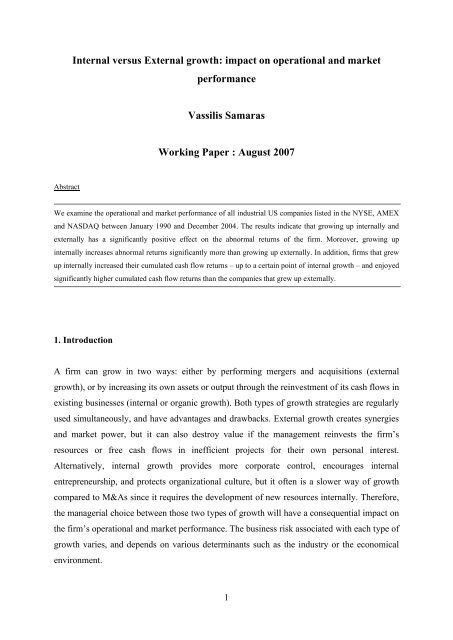
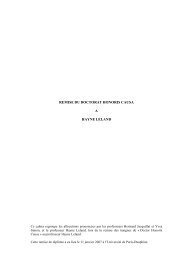

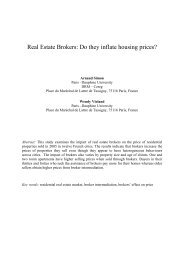
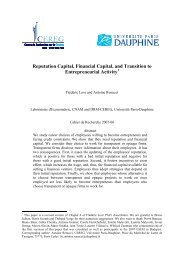

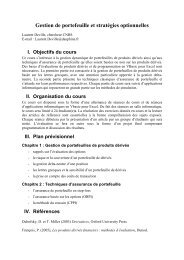


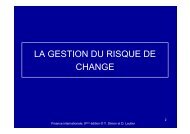
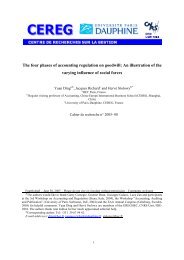
![& 6 ] ^ F ]^ - CEREG - Université Paris-Dauphine](https://img.yumpu.com/33326502/1/184x260/-6-f-cereg-universitac-paris-dauphine.jpg?quality=85)

